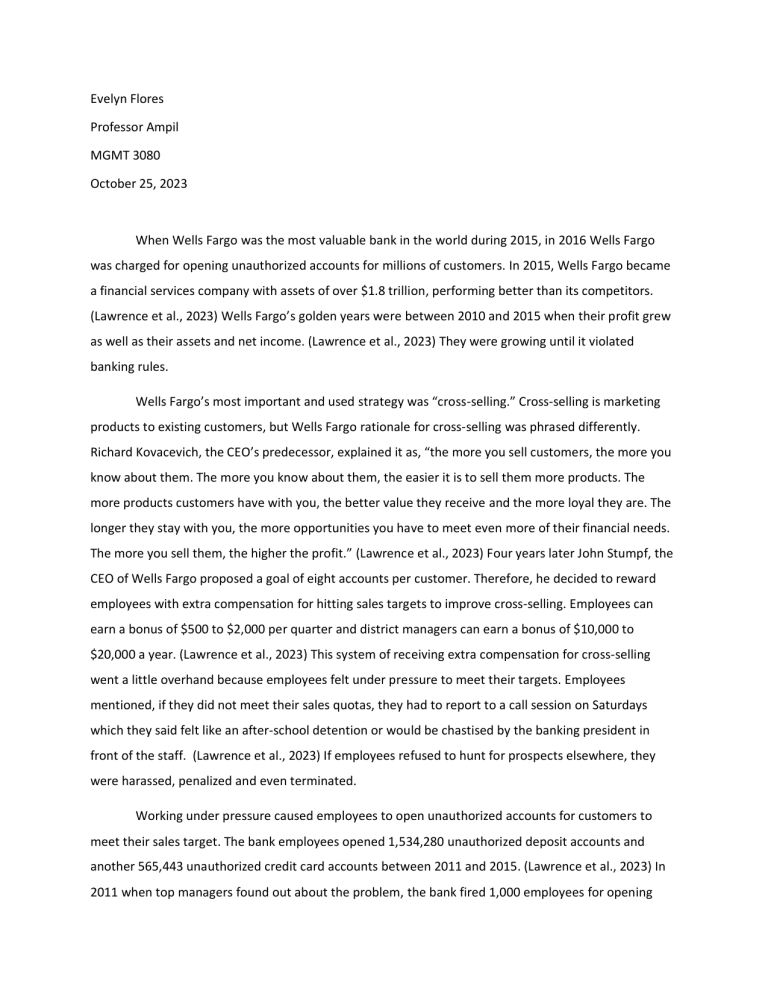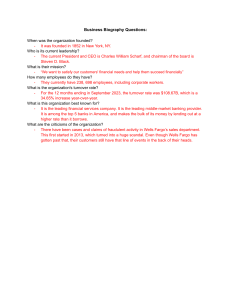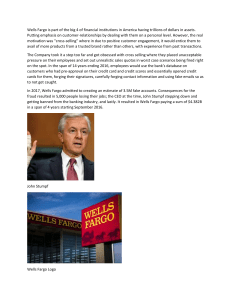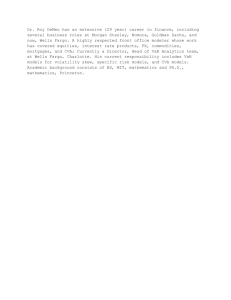
Evelyn Flores Professor Ampil MGMT 3080 October 25, 2023 When Wells Fargo was the most valuable bank in the world during 2015, in 2016 Wells Fargo was charged for opening unauthorized accounts for millions of customers. In 2015, Wells Fargo became a financial services company with assets of over $1.8 trillion, performing better than its competitors. (Lawrence et al., 2023) Wells Fargo’s golden years were between 2010 and 2015 when their profit grew as well as their assets and net income. (Lawrence et al., 2023) They were growing until it violated banking rules. Wells Fargo’s most important and used strategy was “cross-selling.” Cross-selling is marketing products to existing customers, but Wells Fargo rationale for cross-selling was phrased differently. Richard Kovacevich, the CEO’s predecessor, explained it as, “the more you sell customers, the more you know about them. The more you know about them, the easier it is to sell them more products. The more products customers have with you, the better value they receive and the more loyal they are. The longer they stay with you, the more opportunities you have to meet even more of their financial needs. The more you sell them, the higher the profit.” (Lawrence et al., 2023) Four years later John Stumpf, the CEO of Wells Fargo proposed a goal of eight accounts per customer. Therefore, he decided to reward employees with extra compensation for hitting sales targets to improve cross-selling. Employees can earn a bonus of $500 to $2,000 per quarter and district managers can earn a bonus of $10,000 to $20,000 a year. (Lawrence et al., 2023) This system of receiving extra compensation for cross-selling went a little overhand because employees felt under pressure to meet their targets. Employees mentioned, if they did not meet their sales quotas, they had to report to a call session on Saturdays which they said felt like an after-school detention or would be chastised by the banking president in front of the staff. (Lawrence et al., 2023) If employees refused to hunt for prospects elsewhere, they were harassed, penalized and even terminated. Working under pressure caused employees to open unauthorized accounts for customers to meet their sales target. The bank employees opened 1,534,280 unauthorized deposit accounts and another 565,443 unauthorized credit card accounts between 2011 and 2015. (Lawrence et al., 2023) In 2011 when top managers found out about the problem, the bank fired 1,000 employees for opening unauthorized accounts. Employees found it unfair, so they delivered petitions about the link between the high pressure they experienced for the sales quota and the fraudulent opening of unauthorized accounts. An employee, Dennis Russell, mentioned that he was expected to refer 23 percent of his callers to a sales representative even though his customers were in big financial struggles. Russell later got fired for defending his customers, complaining to the sale representatives to not sell to customers who didn’t have good finances and who were also in high debt. (Lawrence et al., 2023) Other employees were terminated for refusing to be unethical. Stumpf accepted full responsibility and said the bank would take further action to gain the customers' trust back. At the congressional hearings he said, “We recognize now that we should have done more sooner to eliminate unethical conduct or incentives that may have unintentionally encouraged that conduct.” (Lawrence et al., 2023) Wells Fargo fired 5,300 employees that opened unauthorized accounts between 2011 and 2015, but Stumpf added that 5,300 represented a small percentage of employees that had done nothing wrong. (Lawrence et al., 2023) Later, the bank had to refund $2.6 million to customers. The bank eliminated sales goals but did not back away completely from cross-selling. There was a long–term overhang of Wells Fargo’s unauthorized accounts case. In 2017, the estimate of unauthorized accounts increased to 3.5 million with an additional $2.8 million in refunds to customers. (Tayan, 2019) A year later the company was placed a strict limit on their asset size by the Federal Reserve Board for the many unauthorized open accounts. A settlement that was not added in the case was a $1 billion settlement the bank agreed to in order to resolve auto and mortgage lending violations. (Tayan, 2019) The bank also agreed to pay $480 million to settle a securities class action lawsuit over cross- selling. (Tayan, 2019) Wells Fargo staff were not able to control their emotions. They went overboard with their strategy of cross-selling. Money driven was getting out of control for the higher representatives because they wanted larger growths of profit for the company. Therefore, they pressured, harassed, and chastised the employees to meet their sales goals, which caused more problems for Wells Fargo. After taking responsibility for the consequences of their unethical actions, Wells Fargo CEO said they will still continue with the cross-selling strategy. I believe this mistake can be repeated because once it happens it can happen again. Wells Fargo should back away from cross-selling. References Lawrence, A. T., & Weber, J. (2023). Business and Society: Stakeholders, ethics, public policy. (7th edition). McGraw Hill. Tayan, B. (2019) The Wells Fargo Cross-Selling Scandal. Harvard Law School Forum on Corporate Governance. https://corpgov.law.harvard.edu/2019/02/06/the-wells-fargo-cross-sellingscandal-2/





